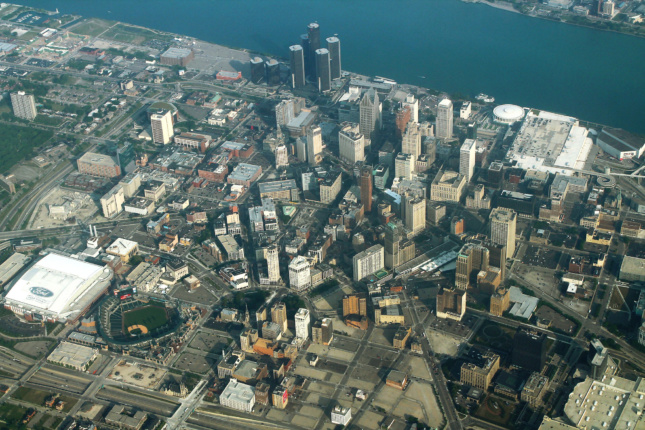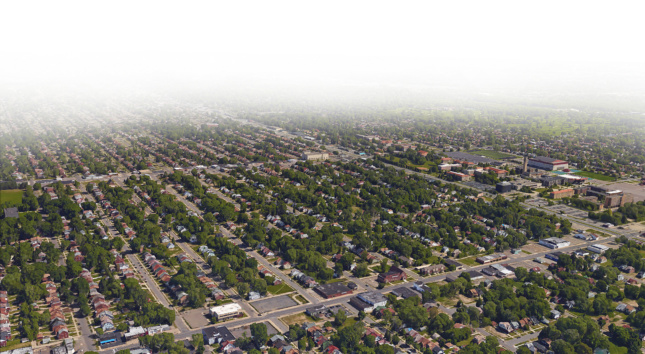Detroit is an entrepreneurial city. In its heyday, it was full of forward-thinkers who were breaking boundaries by building big business dedicated to innovation and manufacturing. That same spirit still exists in the Motor City today, though some have written off the gritty, Michigan enclave as a place of the past. Many dedicated Detroit natives are working hard to rebuild its legacy as a capital of American economic and cultural development.
Kimberly Dowdell, in particular, is using her experience as an architect and a real estate developer, as well as her innate entrepreneurial drive, to change the face of urban housing in Detroit. Along with her team at Century Partners, an emerging firm in the city, she’s tackling long-standing social injustices through the lens of home ownership. She’s doing the same in her new role as president of the National Organization for Minority Architects (NOMA) by advancing representation in the architecture industry and fighting for professional equity.
AN spoke with Dowdell about her unique career path, what drives her to rebuild Detroit, and why addressing architecture’s internal issues can help build stronger cities.
The Architect’s Newspaper: You spent time on the East Coast working as an architect and developer, and then studied public administration as a graduate student at Harvard University. What drew you back to Detroit?
Kimberly Dowdell: I grew up in Detroit in the early ’90s when the city was in pretty bad shape. The buildings were ghosts of their former selves, which fascinated me, but economically, Detroit was devastated. Instead of moving back after graduating from Cornell with my bachelor’s in architecture, I decided to sample cities on the East Coast (Washington, D.C., and New York), rounding it all off in Cambridge for the Harvard program. Many people ask me why I studied government since I came from a design background, but I firmly believe buildings are intrinsically part of the public realm, so it’s our responsibility to learn everything we can about how policies can work to better the built environment. In 2015, I was recruited by the City of Detroit’s Housing and Revitalization Department, where I worked closely with the Planning and Development Department, collaborating with a long-time mentor, Maurice Cox, Detroit’s Planning Director. That unique opportunity to contribute to Detroit’s resurgence ended my 14-year East Coast tour.

AN: Since you’ve been in Detroit, you’ve transitioned into a more entrepreneurial role as a professional and within your current firm, Century Partners. How does your background in public service and design serve you in thinking about housing in Detroit?
When I was younger, I didn’t like that Detroit looked bad, so I decided I was going to become an architect. I didn’t really see many people trying to solve the city’s big problems growing up, so I aimed to do it myself. A lot of what I’ve chosen to do in my career has been in response to things that I think are not ideal. As a kid, I actually wanted to be a doctor, which is funny now because I consider myself kind of like a doctor at the macro level. I get to help heal neighborhoods. Architects have to be knowledgeable of all the issues at hand in order to get a project done successfully. To be a developer, you also have to understand the bigger politics at play. With Century Partners, I’m able to use my design eye as I try to maintain the historic fabric of Detroit as much as possible through our projects.
AN: What’s the biggest thing you’re working on at Century Partners?
Detroit is well-known for its expanse of single-family homes. We’re currently looking at building out neighborhoods that are positioned to contribute to the multi-family housing fabric of the city. We’re currently fundraising to purchase commercial and multi-family buildings in Detroit’s core that will spur economic development, increase density, and create a 24/7 neighborhood. The other major project that we’re working on right now is called the Fitz Forward Neighborhood Revitalization project, a city-backed, public-private partnership that will eventually revitalize over 300 parcels of land, including existing homes, open lots, and parkland, across the Fitzgerald neighborhood in central Detroit.
AN: You spend a lot of time thinking about Detroit’s future and how to solve these big-picture problems. How is this mindset helpful as you start your new position leading NOMA?
I’m three months into my presidency and the biggest thing I want to be really mindful of is fundraising for the organization. As a woman, I think there’s a general consensus that we don’t directly ask for money—as if fundraising is a taboo thing to do. But as president, I want to commit to doing that, which coincidently ties into my fundraising efforts with Century Partners for the commercial property and multi-family housing fund I mentioned. Money is always part of the bigger picture in architecture, but it’s a new challenge for me to think about it so directly.

AN: How could more money for your organization have an impact on architecture?
I was recently possessed to say out loud in a podcast interview that if someone gave NOMA a million dollars, it could change the face of the profession. We’d have money to fuel our access-related programs like exposing K-5 students to architecture through classes and products, while middle and high school students could more deeply engage with our NOMA Project Pipeline summer camps. College students, especially aspiring architects of color, need help with studio supplies, technology, housing, transportation, and scholarships.
As the first millennial president of NOMA, I’ve also begun considering how the architecture profession can alleviate the student debt crisis. Many of my colleagues have really high levels of student debt coupled with comparatively low professional salaries (consider lawyers and doctors) and limited flexibility and financial freedom. How can we as an organization motivate or incentivize people to pursue architecture knowing that compensation is a challenge and the student loan debt is higher than ever? We will miss out on some really talented people if things don’t change.
This is also a diversity issue. Minorities in particular struggle with this given the wealth gap. NOMA is about getting people to believe in the power of diversity and the success of companies and organizations who support that vision. I want to make the case that investing in NOMA is investing in the future of a more diverse and equitable profession, which can help build more diverse and equitable cities.
AN: So you think addressing the architecture’s internal inequalities would have a trickle-down effect on not only the way firms are set up, but how projects and cities get built?
I absolutely think that there is a correlation between who is empowered to author the built environment and how that environment shapes the well-being of the community that it serves. In the words of Winston Churchill, “we shape our buildings and thereafter our buildings shape us.” I believe that this statement holds true and I would add that the heightened diversity of our built environment stewards (developers, architects, builders, real estate brokers, etc.) will contribute to a more thoughtful and responsive set of buildings, spaces, and places that will equate to more sustainable cities. I believe in quadruple bottom line sustainability—incorporating financial, ecological, social and cultural priorities. While everyone in the development process has a particular purpose and role, I think that the more we see greater cohesion between those quadruple bottom line priorities, the better off our cities will be moving forward.











